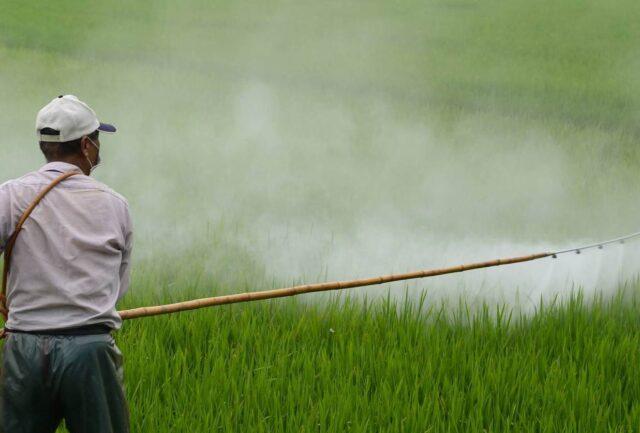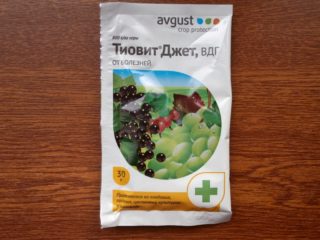Content
- 1 Composition and release form of the herbicide Stomp
- 2 Active ingredient of the herbicide Stomp
- 3 Advantages and disadvantages
- 4 How to prepare a working solution
- 5 Instructions for using the herbicide Stomp per 10 liters of water
- 6 Compatibility with other tools
- 7 Security measures
- 8 Analogues of the herbicide Stomp
- 9 Conclusion
- 10 Reviews of herbicide Stomp
One of the important rules of agricultural technology for vegetable crops is the removal of weeds. To help gardeners, manufacturers of agrochemicals offer the herbicide Stomp - an effective broad-spectrum preparation that will help quickly clear the beds of self-sowing plants and prevent their subsequent appearance.

Stomp herbicide will not harm vegetables
Composition and release form of the herbicide Stomp
Stomp herbicide consists of the active reagent pendimethalin and water. Externally, it looks like a yellow-orange crystalline substance, sparingly soluble in water. The drug is produced in a microencapsulated suspension marked “Professional”, the content of the active substance is 45%.
Until 2017, it was possible to purchase a 33% emulsion concentrate. Then the license for the production of this form of herbicide ceased to be valid and was not renewed.
The manufacturer of the chemical drug Stomp is the German company BASF, which is called one of the leading enterprises on the world market.

The herbicide is produced in 1 liter containers
Active ingredient of the herbicide Stomp
The active ingredient of the herbicide Stomp is pendimethalin, which belongs to the class of dinitroanilines. Its content in the finished product is 33-45%.
The principle of action of the chemical is that pendimethalin, pendimethalin, penetrates into plants through the root system along with moisture and interferes with protein synthesis. As a result, cell division stops, the plant stops growing, and then dies.
Treatment with Stomp in the correct dosage helps clear the beds of:
- bluegrass annua;
- blizzards;
- chicken millet;
- purslane;
- woodlice;
- knotweed;
- tenacious bedstraw;
- field chamomile;
- black nightshade;
- pikulnik;
- violets;
- field forget-me-not;
- purple clasp;
- Veronica;
- common ragwort;
- field torics.
Although Stomp does not work very well on perennials, using it helps reduce weeds such as shepherd's purse and field grass.

The active reagent quickly penetrates the cells of weeds
Advantages and disadvantages
Thanks to its ability to actively suppress annual weeds, the herbicide Stomp has gained popularity among gardeners. However, this pesticide also has disadvantages.

If the herbicide is used correctly, the weeds will die within three days.
Pros:
- wide spectrum of action (suitable for protecting almost all vegetable crops);
- one treatment is enough to get rid of weeds;
- prolonged exposure;
- UV resistance;
- no need to loosen the soil after spraying;
- harmlessness to cultivated plants;
- minimal level of danger for people and bees;
- the ability to destroy not only weeds, but also pests;
- completely decomposes in soil within 75 days;
- does not cause resistance in weeds as a result of annual use;
- absence of a pungent odor in the working solution.
Minuses:
- low level of effectiveness against wheatgrass, which is one of the most common and difficult to remove weeds;
- the need for repeated processing of virgin areas to achieve a good result;
- works well only on light fertile soils; treatment of clay, peat soil or floodplain meadows may be ineffective;
- impossibility of use in fields with cereal crops;
- decreased efficiency in hot weather;
- the impossibility of spraying using aerial technology, which makes the use of herbicide labor-intensive in large agricultural farms.
How to prepare a working solution
The process of preparing the working solution involves diluting the Stomp herbicide consumption rate in water according to the instructions.
During work:
- dissolve the drug in a small amount of water;
- stirring continuously, add water to the required volume;
- the prepared solution is poured into the sprayer.

The working solution must be used on the day of preparation.
Instructions for using the herbicide Stomp per 10 liters of water
Treat the soil with the herbicide Stomp once a season before or shortly after planting vegetable crops. In order for this event to provide a good result, it should be carried out in accordance with the instructions included with the drug.
Experts recommend:
- cultivate the soil within the prescribed time frame, which may differ depending on the type of crop;
- work with the herbicide in dry, windless weather at a temperature of +10-20 °C;
- when the air warms up above normal, it is recommended to increase the concentration of the drug;
- when working on heavy clay soils, the dosage is also increased;
- carry out treatment on pre-moistened soil;
- distribute the preparation evenly over the soil surface;
- do not use fruits for food during the waiting period, which ranges from 25 to 60 days depending on the type of crop;
- water the soil for 10-14 days after treatment to accelerate germination and subsequent death of weeds;
- It is recommended to treat the land plot until two true leaves appear.
Herbicide Stomp for potatoes
Potato beds are treated with Stomp herbicide after deepening the seed material or at the germination stage.
The recommended dosage of the drug is 150 mg per 10 liters of water. The waiting period for Stomp herbicide for this crop is 30 days.Therefore, soil cultivation can be carried out no later than a month before harvesting potatoes.

A short waiting period eliminates the presence of toxic substances in tubers
Herbicide Stomp for cabbage
Cabbage beds are sprayed with herbicide before seedlings are planted in open ground. In this case, the working solution is made at the rate of 90-180 mg of concentrated drug per 10 liters of water (depending on the type of soil). It takes 3-6 liters of the finished product to process 1 hectare.
The waiting period for Stomp for cabbage is 40 days.

Treating beds with herbicide helps to get a good cabbage harvest without any extra effort.
Treatment of onions with Stomp herbicide
In this case, the beds are treated in accordance with the instructions for using the herbicide Stomp on onions before planting or immediately after planting before emergence.
The solution is prepared in a proportion of 70-135 mg per 10 liters of water. The waiting period for this crop is 40 days.

The consumption of the working solution is about 5 liters per hundred square meters
Herbicide Stomp for peppers and eggplants
The soil for peppers and eggplants should be treated with herbicide before planting seedlings. The dosage of the drug for these crops is 90-180 mg per 10 liters of water,
Vegetables can be consumed no earlier than 35 days from the moment the beds are processed.

There will be fewer pests in treated beds
Herbicide Stomp for tomatoes
In this case, the soil is cultivated before the tomato seedlings are transferred to open ground. The working solution is prepared at the rate of 90-180 mg per 10 liters of water. The waiting period for herbicide for tomatoes is 35 days.

The tomato harvest in a clean, weed-free garden will be better.
Other
Stomp herbicide is used to treat beds for carrots, legumes, peas and other vegetable crops. The soil is sprayed before planting or after the seeds are buried in the ground.
You can watch the video on how to use Stomp:
The consumption of the drug is 200-400 l/ha and depends not only on the type of crop, but also on weather conditions in the near future. So, for example, in the event of a large amount of precipitation, the reagent will quickly be washed out of the soil, and if the air temperature rises excessively, it will evaporate from it just as quickly.
Therefore, before spraying the soil with Stomp herbicide, it does not hurt to familiarize yourself with the weather forecast for the next ten days.

Carrots can be processed after emergence
Compatibility with other tools
Experts do not recommend mixing Stomp herbicide with other drugs. Otherwise, processing efficiency may decrease.
Security measures
Herbicide Stomp belongs to the third class of toxicity, that is, it does not pose a serious danger to people and pollinating insects. However, contact of toxic chemicals on open areas of the body and inside the body can cause problems such as irritation, allergic reactions, nausea and vomiting.
Following safety rules will help you avoid such problems:
- When mixing the working solution, do not use containers for cooking or storing food;
- till the soil in closed clothing (preferably overalls) and rubber boots;
- protect your hands with gloves, and the mucous membranes of the mouth, eyes and nose with goggles and a respirator;
- spray the soil in calm weather;
- there should be no children or animals nearby during treatment;
- after carrying out the work, take a shower and wash the overalls;
- pour unused working solution down the drain;
- store the herbicide hermetically sealed in a cool, dry place out of reach of children and pets.
The distance of the treated area from residential premises should be at least 15 m, from water bodies - 1500 m.

Ideally use a sprayer with a long boom
Analogues of the herbicide Stomp
As analogues of the herbicide Stomp, you can use other pesticides that contain pendimethalin. The most popular today are Cobra, Estamp, Fist, Prospect, Penitran, Gaitan.
Conclusion
Herbicide Stomp is a drug whose use makes it possible to forget about weeds for a long time and reduce the amount of garden work. Effective in the fight against monocotyledonous and dicotyledonous annual grasses that do not form bulbs.








